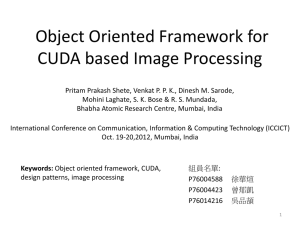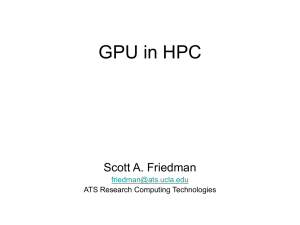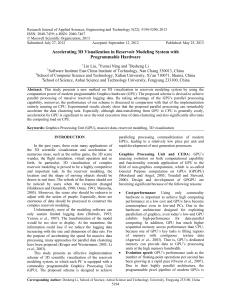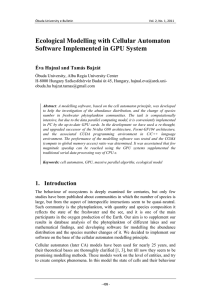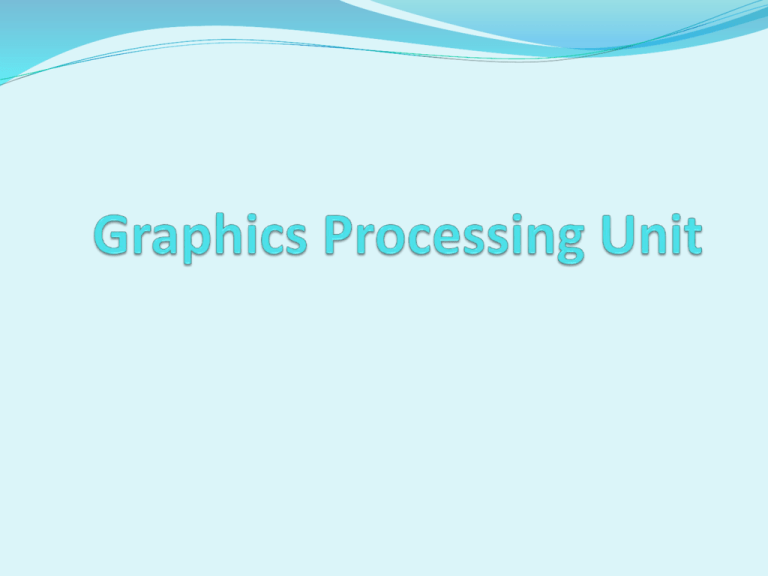
Introduction
What is GPU?
• It is a processor optimized for 2D/3D graphics, video,
visual computing, and display.
• It is highly parallel, highly multithreaded multiprocessor
optimized for visual computing.
• It provide real-time visual interaction with computed
objects via graphics images, and video.
• It serves as both a programmable graphics processor
and a scalable parallel computing platform.
• Heterogeneous Systems: combine a GPU with a CPU
GPU Evolution
• 1980’s – No GPU. PC used VGA controller
• 1990’s – Add more function into VGA controller
• 1997 – 3D acceleration functions:
Hardware for triangle setup and rasterization
Texture mapping
Shading
• 2000 – A single chip graphics processor ( beginning of GPU
term)
• 2005 – Massively parallel programmable processors
• 2007 – CUDA (Compute Unified Device Architecture)
GPU Graphic Trends
• OpenGL – an open standard for 3D programming
• DirectX – a series of Microsoft multimedia programming
•
•
•
•
•
•
•
interfaces
New GPU are being developed every 12 to 18 months
New idea of visual computing:
combines graphics processing and parallel computing
Heterogeneous System – CPU + GPU
GPU evolves into scalable parallel processor
GPU Computing: GPGPU and CUDA
GPU unifies graphics and computing
GPU visual computing application: OpenGL, and DirectX
GPU System Architectures
• CPU-GPU system architecture
– The Historical PC
– contemporary PC with Intel and AMD CPUs
• Graphics Logical Pipeline
• Basic Unified GPU Architecture
– Processor Array
Historical PC
FIGURE A.2.1 Historical PC. VGA controller drives graphics display from framebuffer memory. Copyright © 2009
Elsevier, Inc. All rights reserved.
Intel and AMD CPU
FIGURE A.2.2 Contemporary PCs with Intel and AMD CPUs. See Chapter 6 for an explanation of the components and
interconnects in this figure. Copyright © 2009 Elsevier
Graphics Logical Pipeline
FIGURE A.2.3 Graphics logical pipeline. Programmable graphics shader stages are blue, and fixed-function blocks are white.
Copyright © 2009 Elsevier, Inc. All rights reserved.
Basic Unified GPU Architecture
FIGURE A.2.4 Logical pipeline mapped to physical processors. The programmable shader stages execute on the
array of unified processors, and the logical graphics pipeline dataflow recirculates through the processors. Copyright ©
2009 Elsevier, Inc. All rights reserved.
Processor Array
FIGURE A.2.5 Basic unified GPU architecture. Example GPU with 112 streaming processor (SP) cores organized in 14
streaming multiprocessors (SMs); the cores are highly multithreaded. It has the basic Tesla architecture of an NVIDIA
GeForce 8800. The processors connect with four 64-bit-wide DRAM partitions via an interconnection network. Each SM
has eight SP cores, two special function units (SFUs), instruction and constant caches, a multithreaded instruction unit,
and a shared memory. Copyright © 2009 Elsevier, Inc. All rights reserved.
Compare CPU and GPU
Nemo-3D
• Written by the CalTech Jet Propulsion Laboratory
• NEMO-3D simulates quantum phenomena.
• These models require a lot of matrix operations on very large
matrices.
• We are modifying the matrix operation functions so they use
CUDA instead of that slow CPU.
Nemo-3D
Simulation
NEMO-3D
Computation
Module
CUDA
kernel
Visualization
VolQD
Testing - Matrices
• Test the multiplication of two matrices.
• Creates two matrices with random floating point values.
• We tested with matrices of various dimensions…
Results:
Dim\Time
CUDA
CPU
64x64
0.417465 ms
18.0876 ms
128x128
0.41691 ms
18.3007 ms
256x256
2.146367 ms
145.6302 ms
512x512
8.093004 ms
1494.7275 ms
768x768
25.97624 ms
4866.3246 ms
1024x1024
52.42811 ms
66097.1688 ms
2048x2048
407.648 ms Didn’t finish
4096x4096
3.1 seconds Didn’t finish
In visible terms:
CPU versus GPU
70000
CUDA
CPU
CPU regression
CUDA regression
y = 10.682e0.0085x
R2 = 0.9813
Execution time (ms)
60000
50000
40000
30000
20000
y = 0.3526e0.0053x
R2 = 0.9575
10000
0
0
200
400
600
800
Matrix side dimension
1000
1200
Test results:
Function Execute Time
500
y = 0.0228x - 0.5522
R2 = 1
450
Milliseconds
400
350
CUDA
300
CPU
250
CPU trendline
200
CUDA trendline
150
100
y = 0.0015x - 0.3449
R2 = 0.9996
50
0
0
5000
10000
15000
Number of Atoms
20000
25000



